Morro Bay Water Reclamation Facility Project: Issues, Concerns, and Solutions
Note to readers: The following paper is public record. Formatting, including links, has been added to enhance the document’s readability on the Web; however, content is just as submitted to State and local agencies. External documents for which links are provided are also public record, having been originally published on the City site, provided by local and state agencies in response to public record requests, or formally submitted to the City of Morro Bay.
A History of Sewage Contamination of Morro Bay Municipal Wells
2002 to the Present
April, 2016
Sewage from a dilapidated sewage collection system has been contaminating Morro Bay groundwater for years. However, the City of Morro Bay and the Regional Water Quality Control Board (RWQCB) have long denied that any significant problem exists. In 2015, when publicly presented with irrefutable evidence of sewage in the Morro Basin aquifer, RWQCB members stated that this kind of problem exists all over the State, and that as long as the City has an adequate potable water supply, the Board will take no action. The decision was made despite the evidence that the City’s Morro Basin drinking water wells are being impacted.
It has long been suspected that the reason for the reluctance of the City to acknowledge the problem is that doing so would also require acknowledgement of the fact that the City has failed to maintain the sewage collection system, which has fallen into a disastrous state of disrepair. The suspected reason for the RWQCB’s unwillingness to acknowledge the problem is the fact that it appears likely that a project overseen by that agency breached the Morro Basin aquifer boundary, allowing exfiltrated sewage to enter the aquifer and thus contaminate municipal wells.
2002: The first known evidence of sewage contamination of groundwater appears
The first known evidence of sewage contamination of Morro Bay groundwater appeared in 2002. In November of that year, there was a dramatic spike in the nitrate concentrations in the Morro Basin municipal wells, which draw water from the Morro Basin aquifer. That aquifer consists of underground rivers and streams that move slowly, in a westerly direction, toward the sea.
Prior to 2002, nitrate levels in the wells had never exceeded the maximum contaminant level. However, in the fall of that year, nitrate levels began to spike suddenly and dramatically whenever the wells were used, dropping back to normal when well use stopped.
Morro Bay began using State water in 1997, and thereafter, used the municipal wells only during the annual State water maintenance shutdown, which ordinarily occurs in November. The following chart shows the sudden dramatic pattern shift in nitrate levels every November from the years 2002 through 2006:
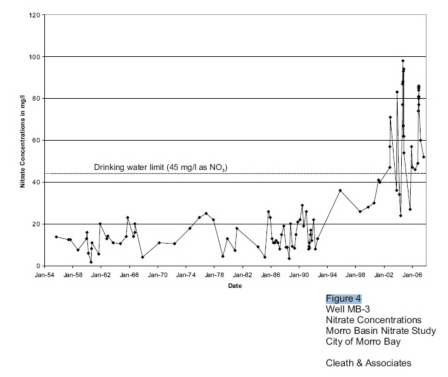
2002 – 2005: City staff appears to purposely conceal well contamination
Data obtained from the California Department of Public Health shows that City staff first became aware of the nitrate spikes in 2002, and that they had data showing the nitrate spikes in the ensuing years. However, City staff failed to report the alarming trend to the Council and the public. In addition, it appears that the problem may have been deliberately concealed. False, artificially-
The nitrate levels reported in the years 2002 through 2005 differed radically from the actual levels recorded in the well test data sent to the CDPH. The following table gives the specific nitrate data included in the 2002 -
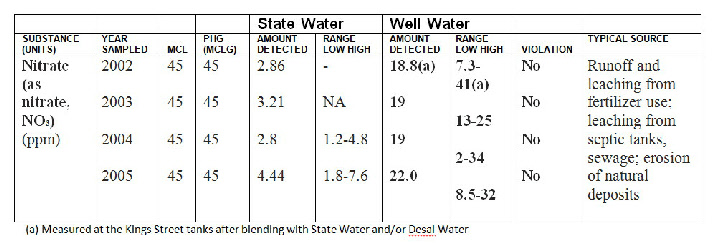
Yet, as City staff was reporting artificially-
Was this deliberate concealment of a sudden and serious nitrate contamination problem? Why did City staff not state the true nitrate levels in the wells in these important, legally-
2006: The public becomes aware of the nitrate contamination of City well water
In November, 2006, the nitrate problem became known to the public when the City notified its water customers that water with nitrate levels over the maximum contaminant levels had been delivered to their homes. This water delivery occurred during the annual State Water maintenance shutdown when the City was relying on well water. High nitrate levels in drinking water can cause serious health problems, and this was a true public health emergency.
The November 15, 2006 minutes of the Morro Bay Public Works Advisory Board state that a senior City staff member Bill Boucher had an announcement. The minutes say that, “Boucher explained the City was having a problem with its drinking water. Tests done today show the Nitrate level at 48 mg/liter and the State and Federal limit for Nitrates is 45 mg/liter.” Water customers were subsequently notified of the problem.
Subsequently, there were complaints from the public that the City failed to notify water customers and the County health department of the problem in a timely manner.
2007:
- Morro Bay residents investigate the condition of the sewer
- City admits sewer condition problems
- City denies responsibility for sewer system degradation
- City staff appears to attempt to influence the results of a City-
funded nitrate study - City–funded nitrate study claims nitrates are from fertilizer
Morro Bay residents investigate the condition of the sewer
Morro Bay residents Richard Sadowski, a Grade 4 CWEA collection system expert, and Marla Jo Bruton, a local clean water activist, reviewed numerous video inspections of Morro Bay sewer lines and prepared a report which was distributed to the City Council and the RWQCB in October, 2007.
Reviewing a sample of video inspections obtained from the City, Sadowski and Bruton reviewed and logged defects identified in video inspections of approximately 8,065 feet (about 1.52 miles) of sewer lines around the City. They found that, on average, every 11.4 feet, there were sewer line defects with potential for inflow and infiltration (I&I) and/or sewage exfiltration into the soil.
The following table summarizes some of the findings of this study:
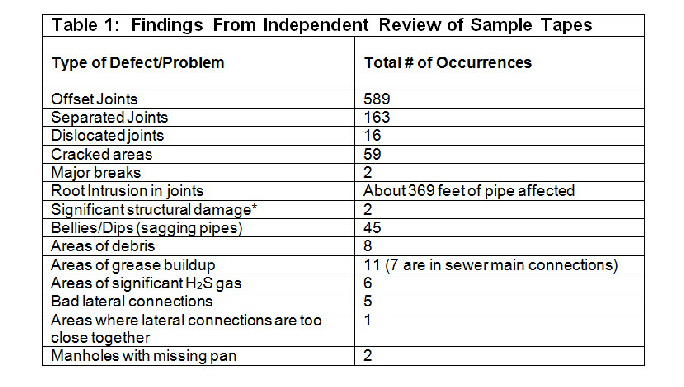
City admits sewer condition problems
Shortly before the Sadowski/Bruton study was published, the City admitted the sewer lines were in poor condition. Whether or not this was a reaction to the fact that residents were conducting a study of the sewer system condition is unknown, but in a document titled “Water and Wastewater News”, mailed to Morro Bay residents in September, 2007, the City admitted the system needed repair. On page 2 of the document are the following statements:
“Most of our collection system is now over 50 years old and is showing its age ... A number of pipeline segments are now too small and have cracks, offsets and similar problems ...”
and,
“The Master Plan’s computer model identified a number of sewer pipeline segments as being currently over capacity during highest wet weather flow conditions. The major pipe segment identified in this condition is along Main Street from Vashon to Atascadero Road and on Atascadero Road for Main Street to Park Avenue.
We have started design on the upgrade of this pipeline and plan to construct in in fall 2008”
The referenced lines along Main Street and Atascadero Road are major trunk lines that carry very high volumes of sewage. Unfortunately, despite the promise made in the 2007 document, the City has NOT, as of this writing, repaired the line along Main Street from Vashon to Atascadero Road. The City’s Public Works Director recently stated that the repairs will not be done for four more years.
City denies responsibility for sewer system degradation
Immediately after the sewer line condition study by Sadowski and Bruton was distributed, City staff disputed it. They did so despite having recently issued their own statement, in the City’s “Water and Wastewater News”, that,
“Most of our collection system is now over 50 years old and is showing its age ... A number of pipeline segments are now too small and have cracks, offsets and similar problems.”
A letter attacking Sadowski and Bruton and denying any wrongdoing by the City was sent to the RWQCB. The letter is undated, but given its content, appears to have been written in late November, or early December, 2007.
The letter included a denial that the sewer line problems had been caused by lack of maintenance. Apparently confusing system cleaning with system maintenance, City staff member Dylan Wade stated that,
“The report authors also put forth the claim that the damage observed in our system was largely caused by deferred maintenance. While there is damage to portions of some of the clay pipe in the collections system, the damage observed was not caused by deferred maintenance. "Because vitrified clay pipe is chemically inert, it is not vulnerable to damage due to domestic sewage, sulfide attack, most industrial wastes and solvents or aggressive soils " (Clay Pipe Engineering Manual). Furthermore the City has a long history with an aggressive cleaning schedule that exceeds industry norms. Our cleaning intervals range from less than monthly to a maximum of biannual cleanings depending on the condition of the pipes. The type of damage observed to some of the pipes in the collections system would appear to be mostly from earth movement, with cracks at bells or displaced joints, and damage from faulty lateral installations.”
Mr. Wade did not explain why, despite their knowledge of the major damage done to the lines by “earth movement” and “faulty lateral installations” responsible City staff members had not made repairs.
City staff appears to attempt to influence the results of a City-
In early 2007, the City commissioned a study to determine the source of the nitrates, but before that study even began, City staff began telling residents that the problem was fertilizer from farming operations east of town in the Morro Valley. The earliest such statement known is one made by City staff member Bill Boucher to a group of mothers concerned about the impacts of the nitrates on their children.
This position was later reflected in a communication between City Staff member Dylan Wade and the consultants who were conducting the nitrate study. In a December 7, 2007 email from consultant Spencer Harris to City staff member Bill Boucher is this statement:
“On the bright side, FYI here's a new paragraph that I put in the report to incorporate Dylan’s reference. I think it's pertinent.
Despite a hydraulic potential for exfiltration along Main Street when the city well field is pumping, gravity sewer leaks quickly become plugged by sewer film and settleable solids in the sewage, theoretically reaching steady-
Thus, it appears that City staff member Dylan Wade asked or told the consultants to include that quote in the nitrate study report. Clearly the quote appears to indicate that sewage exfiltration is not a serious problem, and seems to have steered the consultants away from seriously or extensively studying sewage as a potential source of the nitrates. The out-
However, the quote that Wade provided to the consultants was taken completely out of context. The Amick and Burgess study, which was done for the EPA, was in fact about the seriousness of the problem of sewer exfiltration, and the actual statement from the Amick and Burgess study is this:
“At a pressure head below the sewer crown, which is typically the case in gravity flow sewer lines, exfiltration rates were minimal. At a pressure head of one pipe diameter, the exfiltration rate increased dramatically, to more than 26 gal/hour (gph) per joint in some segments. This high leakage rate can, in part, be attributed to the generally poor condition of the old sewer systems. A linear correlation between pressure head and exfiltration rate for several types of sewer defects was noted for pressure heads greater than 500 mm (20 inches). It was also noted that at lower flows and pressure heads, the exfiltration rate decreases exponentially, most likely from self-
The text that has been emphasized here with bold font, text that was left out of the quote provided by Wade, completely changes the meaning of the quoted passage, in that it clearly indicates that the sealing property discussed is, in many cases, only temporary.
In many locations, exfiltration rates are shockingly high. For example, in the referenced study, Amick and Burgess cite an annual exfiltration rate of 1.65 million gallons per day for Munich, Germany, and a rate of 5 mgd, as the best estimate of the average daily wastewater exfiltration rate from Albuquerque‘s sewer system.
Two cities closer to Morro Bay were also discussed. The following table from the Amick and Burgess study gives exfiltration test results, using two different methodologies, for exfiltration from sewer lines in Berkeley and Santa Cruz.
In summary, it can be said that the out-
At approximately the same time, shortly before the consultants’ nitrate study was completed, City staff member Dylan Wade also told the RWQCB that sewage was not the cause of the nitrate problem. In an undated letter, that appears to have been written in late November or early December, Wade stated,
“Since the primary groundwater contaminant of local concern is nitrates. We are nearing completion of a study regarding the source of this contamination of Morro valley wells and have ruled out sewage exfiltration as a probable source.”
City-
The City-
For example, no change in farming activities could account for the sudden change in nitrate level patterns, and the isotopic signatures of nitrates in the wells were completely inconsistent with those for fertilizer.
Isotopic signatures (15N/14N) of the nitrogen component of nitrates in the wells were, however, strikingly consistent with those of sewage as demonstrated by the table below.
(standard nitrate signatures from a study by wastewater contamination expert Dennis McQuillan )
The following table provides additional detail, including standard values from another source:
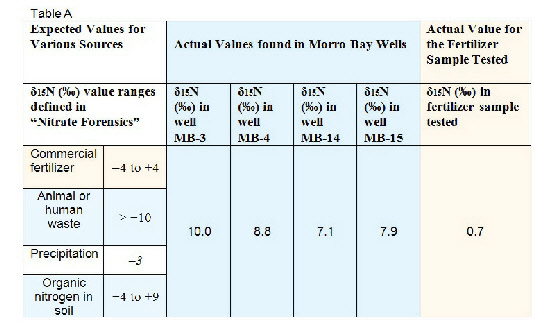
Note that both sources state a range of -
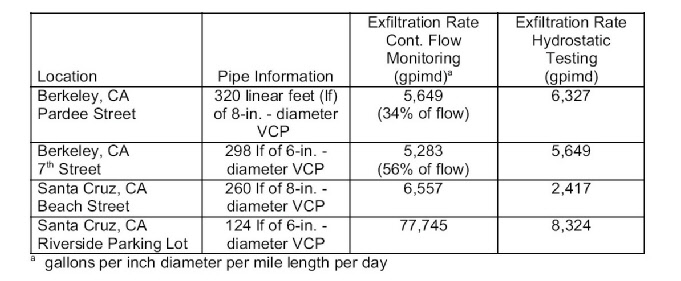
|
Source |
Nitrate Signature |
|
Septic systems: |
7.6 to 12.1 |
|
Sewage treatment plant: |
7.2 to 12.1 |
|
Morro Basin wells: |
7.1 to 10.0 |
|
Commercial Fertilizer |
- |
2008: Morro Bay Residents discover the cause of the nitrate spikes
In 2008, having identified significant weaknesses in the City-
They identified the likely trigger event as an MTBE remediation project, overseen by the RWQCB, that commenced in 2001 and ended in 2002.
The project was done at and in the vicinity of the site of an old gasoline station that had been located over the boundary of the Morro Basin aquifer. This is the aquifer from which several of Morro Bay’s municipal wells draw their water.
Directly to the west of the gasoline station site lies the Main Street sewer trunk line, and an area where Sadowski and Bruton believe that exfiltrated sewage from the line pools underground.
The following diagram shows the location of the station and the nearby wells.
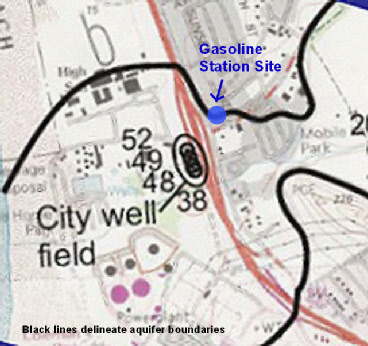
The following diagram, the original of which was produced by the MTBE remediation company, shows the extent of the work done.
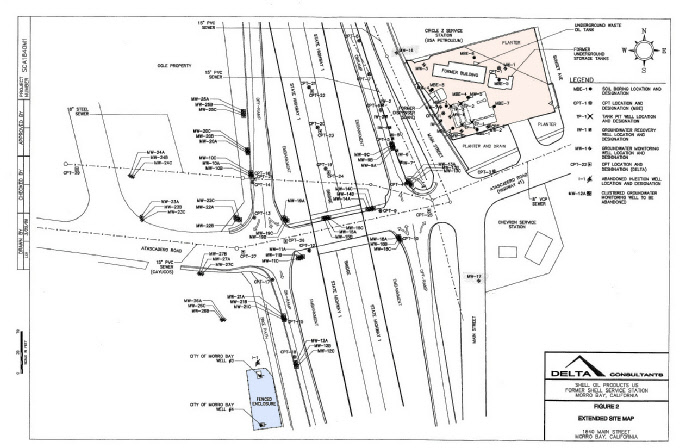
The former location of a gasoline station, which was the source of the MTBE, is shown by the beige-
The numerous black dots show the locations of the 63 monitoring and extraction wells that were drilled into the Morro Basin aquifer, which feeds the City wells
The blue-
Sadowski and Bruton considered a number of factors, including:
Timing of the onset of spikes in nitrate levels in the municipal wells
- Excavations at the gasoline station site
- Locations of the MTBE monitoring and extraction wells,
- Location of the Main Street trunk line
- Condition of the trunk line and the likelihood of significant sewage exfiltration
- Potential for pooling of exfiltrated sewage at the end of this gravity line
- A consultant’s statement that movement of the MTBE plume underground was directly tied to pumping at the well field
They concluded that the MTBE remediation work likely breached the aquifer boundaries, probably both horizontal and vertical, allowing exfiltrated sewage to be drawn into the aquifer when the wells were pumping.
If MTBE could be pulled into the aquifer when the wells were operating then so, surmised Sadowski and Bruton, could exfiltrated sewage. This hypothesis was presented in a paper published and distributed to the Council and the RWQCB in April, 2008.
2009: New evidence supporting the Sadowski-
Resident researcher Linda Stedjee, working with Sadowski and Bruton, discovered that the closer a municipal well was to the suspected source of sewage contamination, the higher the nitrate levels in the well water.
If the nitrates were from fertilizer from the Morro Valley then, since all the wells draw their water from the same aquifer, they should have similar nitrate levels. They did not. Well 03 consistently had the highest nitrate levels followed, in order, by wells 04, 14, and 15. This order corresponds exactly to the wells’ relative distances from the sewage source, with 03 being the closest, and 15 the most distant.
This correspondence between nitrate level in a well and its distance from the sewage source was further supported by the discovery that Morro Bay Mutual Water wells, about a quarter mile south of the municipal wells, never had high nitrate levels. Yet, these wells, like the municipal wells, draw their water from the Morro basin aquifer.
The following image shows the locations of the municipal wells and the Morro Bay Mutual Water wells:
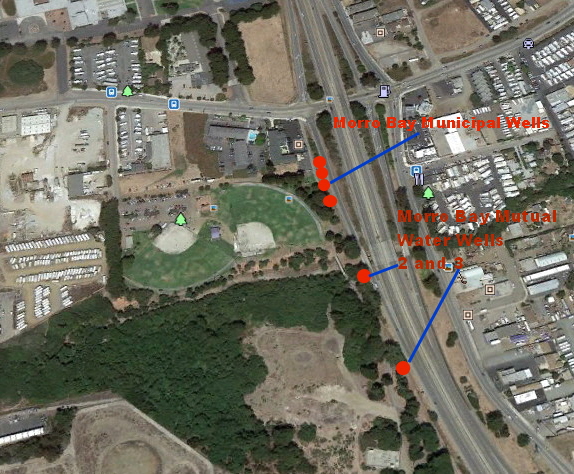
2009 to 2014: Established patterns of nitrate levels in the wells continue
In the ensuing years, the pattern of nitrate spikes was consistently linked to well production, as demonstrated by the following table, which tracks the correspondence from 2009 through the year 2013. Note also that the correspondence between well nitrate levels and distance from the sewage source continued.
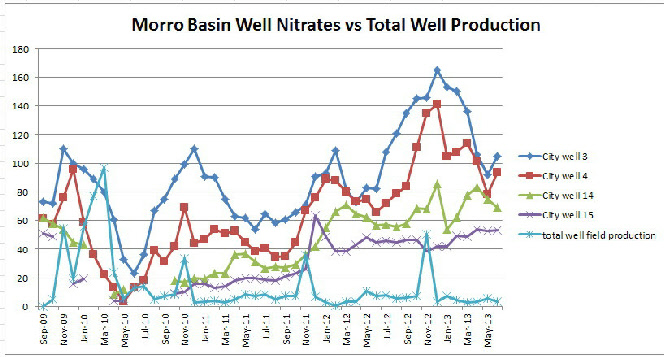
However, despite mounting evidence that sewage was contaminating the aquifer, denials by the City and the RWQCB continued. These agencies continued to offer up questionable theories and excuses. For example, it was claimed that the differences in nitrate levels in the different wells had nothing to do with proximity to exfiltrated sewage, but instead were a result of proximity to Morro Creek. It was claimed that the creek diluted the nitrates in the wells closest to it.
This claim was quickly discredited with the observation that for much of the year, the creek is completely dry; yet, the pattern of nitrate levels in the wells holds through all seasons.
Claims were made from time to time that exfiltration could not occur because the sewer lines lie below the water table. This is completely false. Except in the wettest weather, nearly all lines lie above the water table.
RWQCB staff claimed that the portion of the aquifer beneath the City’s wells was likely hydraulically disconnected from the former Shell station area due to geologic formations in the area. This claim was discredited by documented evidence that, during the MTBE remediation, the movement of the plume, from the area of the service station toward the wells, was tied directly to well usage.
2014: Morro Bay residents convince the RWQCB to conduct tests for components of sewage in the wells
After trying for years to get the RWQCB to publicly hear their concerns, Morro Bay residents were able to get a hearing, which was held on May 22, 2014. Marla Jo Bruton and Linda Stedjee gave a 20-
A few months later, City water staff drew well water samples to be tested for sucralose, which is considered a highly-
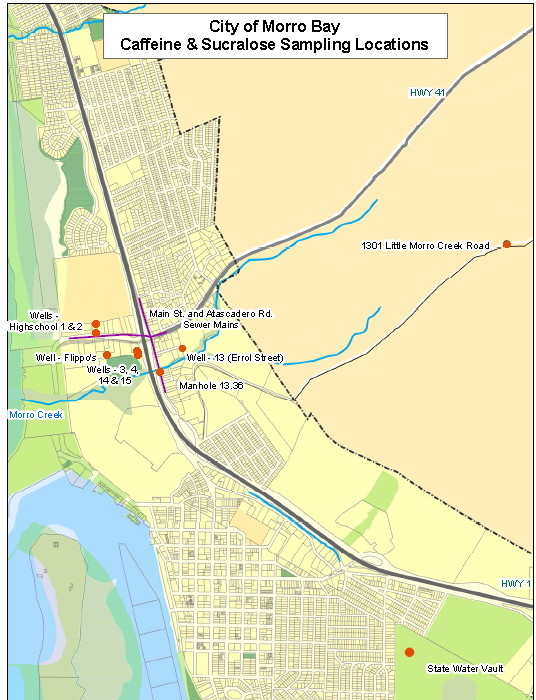
Every well downgradient from Morro Bay sewer lines had significant levels of sucralose. The only well that did not was the one at 1301 Little Morro Creek Road, which is east of town, upgradient of Morro Bay sewer lines, and thus not subject to contamination by sewage leaking from those lines. This evidence clearly demonstrated that there was no sewage contamination coming into Morro Bay from Morro Valley to the east.
This table shows the sucralose test findings:
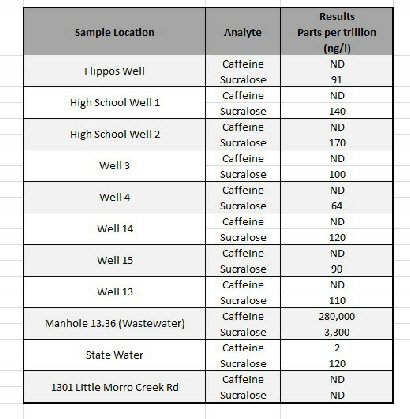
2015: Despite proof of sewage in municipal wells, RWQCB refuses to act
At its May, 2015 meeting, the RWQCB reviewed the sucralose test results and, despite this definitive proof that sewage is contaminating municipal wells, refused to take any action. Board members stated that there were leaky sewer systems all over the State. They said that so long as Morro Bay has access to sufficient potable water to serve its population, the Board will take no action, as they have more important issues to deal with.
2015 to present: City of Morro Bay continues to refuse to acknowledge the problem and repair the sewer lines
City staff members continue to claim that sewage pollution of the wells is insignificant. One senior staff member has said that the sucralose must be coming from State Water, and therefore there is no sewage contamination of the aquifer. This argument ignores two key facts;
1. Even if the sucralose were all from State water, most of the State water used in the City ends up in the sewer, so to get into the groundwater, it would have to have leaked out of the sewer lines.
2. Testing of the private well at 1301 Little Morro Creek Road, to the east of town and upgradient of Morro Bay sewer lines, shows that water in the aquifer is free of sucralose contamination before reaching Morro Bay. When this sucralose-
This would mean that, if the sucralose in the wells is only from State water, then sucralose levels in those wells should be much lower than levels in State water. However, several of the tested wells in Morro Bay had sucralose levels higher than the level in State water. This clearly indicates that State water cannot be the only source of sucralose in the tested wells.
The discovery of clear evidence of the presence of sewage in the municipal wells is not surprising. The following images, from video inspections of the Main Street trunk line, show damage that is the rule, not the exception, for that segment of the collection system – considered by resident researchers to be the source of most, or perhaps all of the sewage contaminating the Morro Basin municipal wells.
1. Sections of line south of San Jacinto Street. Note the badly-
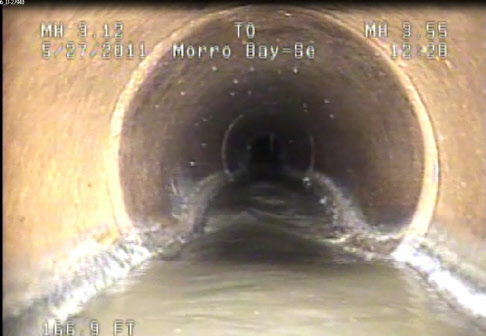
2. Below is an image of more very badly-
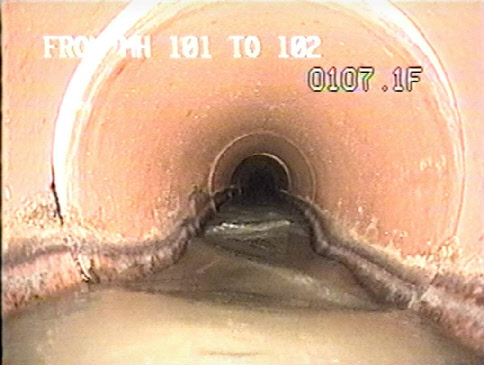
3. Serious root intrusion north of Mindoro. This indicates an open pipe joint.
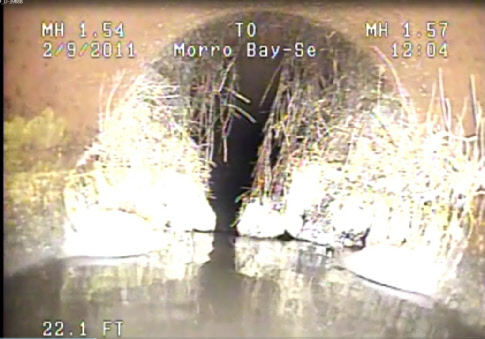
4. Major cracking in two adjacent pipe sections between Bonita and La Jolla
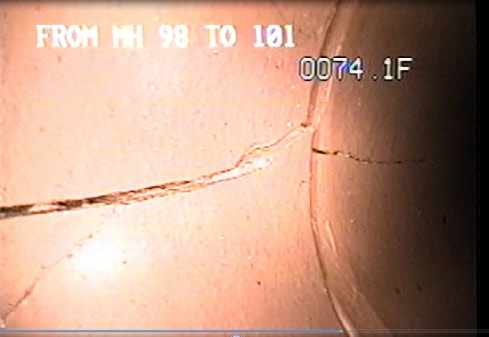
Despite all of the evidence that major contamination is going on, local agencies have refused to act, and the City has indicated that the Main Street trunk line, site of the damage shown in the photos above, will not be repaired for four more years.
| history |
| Finance |
| Collection System |
| Recommended Solution |
| approaches and technology |
| deja vu |
| contamination history |
| collection system issues |
| drinking water impacts |
| Addressing site Challenges |
| approaches and technology |
| deja vu |
| contamination history |
| collection system issues |
| drinking water impacts |
| Addressing site Challenges |